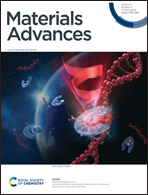Synthesis of oxanorbornene-based phosphonium polymeric ionic liquids (PILs) and investigation of their electrical properties†
Abstract
In this study, a series of phosphonium polymeric ionic liquids (PILs) was synthesized via ring-opening metathesis polymerization (ROMP), and the trifluorosulfonylimide anion successfully replaced the bromide anion via ion exchange. Subsequently, the effect of various substituent groups (including triphenyl, tripropyl, tertbutyl and trifluorophenyl) on the conductivity of the PILs was studied. The results showed that an alky substituent backbone resulted in higher conductivity compared to the aromatic functional group-bearing polymer architecture. The optimum conductivity of PILs at room temperature was found to be 6 × 10−4 S cm−1 for the propyl substituent group PILs (SM2) doped with 15 wt% LiTFSI salt. Furthermore, the effect of grafting polyethylene glycol (PEG) units to the polymer backbone on the conductivity value was also investigated.



 Please wait while we load your content...
Please wait while we load your content...